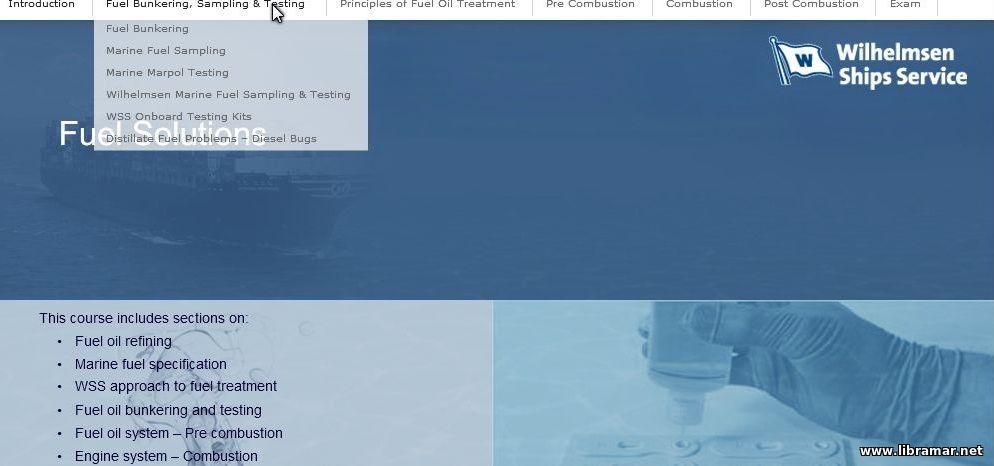Watchkeeping in Port
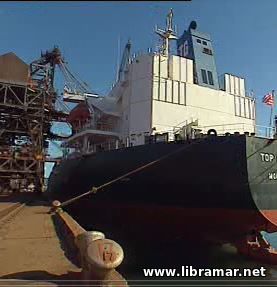
Cargo operations are probably the most important ship operations. They vary enormously from petrochemicals where the discharge is controlled by the ship’s officers to containerships where the discharge and loading is organized and largely carried out by the shore stuff. From your training and experience you will know the requirements of your own ship’s cargo operations but, whatever the cargo, many of the principles remain the same.
Prompt and accurate reporting of any damage must be done within twenty-four hours. Cargo condition, speed of loading or discharging, any delay in operations all can have commercial consequences. The chief officer will know what is critical in your cargo operations and you should discuss the procedures with him. Much of the time cargo operations proceed according to pre-determined plan. It is when the unexpected occurs that the skill of the deck officer is really tested. By responding in the right way you can make a big difference to the commercial performance of your ship.
Make sure you know what can go wrong, what to do and whom to contact if it does. Good situational awareness is the basis for any effective response. Make sure you know what is going on at all times in port. This means being on deck most of the time, keeping your eyes open and communicating with the terminal staff. This will also help with another major task – making sure that the ship is safe.
Current, tide and the cargo operations can all move the ship in relation to the shore if the mooring ropes are slack. 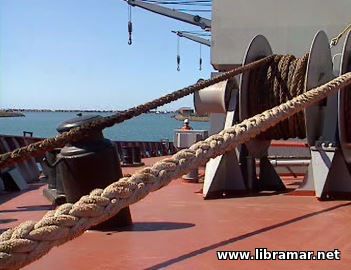 The ropes need to be checked regularly for tautness. If your ship has self-tensioning winches, these are best left on the brake and not left in tension once the ship is secured alongside. In an emergency, never release the brakes and attempt to pull a ship back alongside using the power of the winches alone. You must know the ship’s mooring equipment and be familiar with its operation and capabilities including the type of winch and brake, the size, type and length of lines.
The ropes need to be checked regularly for tautness. If your ship has self-tensioning winches, these are best left on the brake and not left in tension once the ship is secured alongside. In an emergency, never release the brakes and attempt to pull a ship back alongside using the power of the winches alone. You must know the ship’s mooring equipment and be familiar with its operation and capabilities including the type of winch and brake, the size, type and length of lines.
Make sure you are aware of the tidal changes and keep an eye on a weather forecast. Sudden changes can have a big impact on cargo operations and additional mooring arrangements may be needed. Be aware of nearby ship movements, check the lines after any ship has arrived or left the next berth.
You need to make sure that the cargo operations are not compromising the stability of the ship and that the loading and unloading are proceeding equally on port and starboard sides. A surprising number of shore supervisors have little knowledge of ship’s stability and they do not have the final responsibility for it anyway – that rests with the Master, delegated to the main officer on watch.
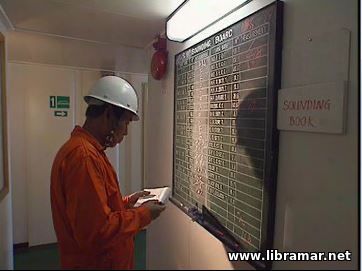 Whatever type of ship you are on, keep an eye on the cargo plan and make sure it is being followed. If you deviate from it then the stability calculations will all have to be re-done before work can proceed. Ballasting will need to be adjusted appropriate as cargo operations proceed, as planned by chief officer. Correct ballasting is crucial to the strength and stability of the ship. If you find that the ballast and cargo plans are out of step, you must call the chief officer immediately.
Whatever type of ship you are on, keep an eye on the cargo plan and make sure it is being followed. If you deviate from it then the stability calculations will all have to be re-done before work can proceed. Ballasting will need to be adjusted appropriate as cargo operations proceed, as planned by chief officer. Correct ballasting is crucial to the strength and stability of the ship. If you find that the ballast and cargo plans are out of step, you must call the chief officer immediately.
While alongside, the OOW needs to know what is going on in the engine room, how many people are working there, are any special operations taking place; if so, is there any potential risk to the personnel or risk of pollution. Pollution has become a major issue in many ports of the world. It is another OOW’s responsibility to ensure that the ship is not polluting the environment. In bunkering procedures the chief engineer may be in charge, but the OOW must be in close contact with the bunkering team throughout the operations to ensure that all steps to avoid and minimize spills have been taken and all anti-pollution gear is on deck and ready for use. He must be familiar with the SOPEP and his responsibilities detailed in it.
Informing the terminal or the local authorities will be one of the first steps in the plan. Any cargo spill can lead to 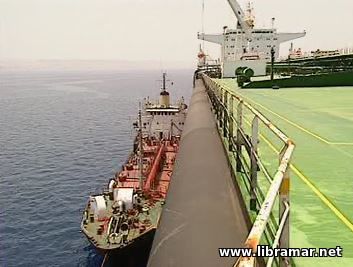 pollution. In addition, many ports are sensitive about the air pollution from the funnel and cargo dust. Noise pollution from chipping machines and pollution from organisms in ballast water can also cause problems, and this is not a complete list. These topics need to be addressed in a management meeting prior to the discharge and passed on to the officers of the watch. In some countries a ship can be fined or even arrested for pollution. So, it is vital for the deck department to be aware of the rules, regulations and sensitivities of each port. Watch out for any pollution in the water that is not due to your ship but might be blamed on you. Keep an eye on the water around the ship and report to the terminal if you see any pollution.
pollution. In addition, many ports are sensitive about the air pollution from the funnel and cargo dust. Noise pollution from chipping machines and pollution from organisms in ballast water can also cause problems, and this is not a complete list. These topics need to be addressed in a management meeting prior to the discharge and passed on to the officers of the watch. In some countries a ship can be fined or even arrested for pollution. So, it is vital for the deck department to be aware of the rules, regulations and sensitivities of each port. Watch out for any pollution in the water that is not due to your ship but might be blamed on you. Keep an eye on the water around the ship and report to the terminal if you see any pollution.
The most important aspect of any operation is personnel safety. Some of those who come on board may have little idea of the ship safety or the specific hazards on your ship. First, make sure that their access is safe; netting should be rigged below the gangway. A lifebuoy with the line and self-igniting light must be nearby and ready for use. Many different groups of people will want to come on board – agents, customs and immigration officials, superintendents, officers and crew, family and friends, ship chandlers, inspectors, salesmen; and then, there are the visitors you do not want – stowaways, traders, thieves, girls… they can cause all kinds of trouble.
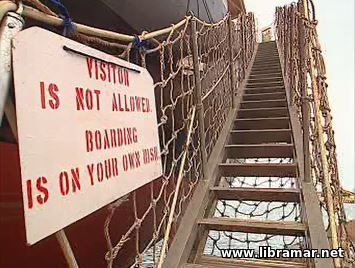 In some ports prostitutes have transferred drugs on ships to be found later by the customs. Prostitutes have also been known to give details of ships to pirates. It is not always possible to tell who is who as they come on board and it is too important to be guessed. That is why, if at all possible, you shall always have a gangway watch – they should politely identify each visitor and make sure that they have official business on board, and either know where to go or are escorted.
In some ports prostitutes have transferred drugs on ships to be found later by the customs. Prostitutes have also been known to give details of ships to pirates. It is not always possible to tell who is who as they come on board and it is too important to be guessed. That is why, if at all possible, you shall always have a gangway watch – they should politely identify each visitor and make sure that they have official business on board, and either know where to go or are escorted.
One benefit of a gangway watch is that every visitor to the ship can be given a safety briefing. You cannot afford to give a security up to the terminal; it is excellent in some ports and does not exist in others.
Stowaways have become a big problem for ships in the recent years. Repatriating them is extremely expensive and often the ship owner is made to pay. Keeping unused areas locked and inspecting cargo holds before they are closed down are two ways the officer of the watch could help minimize this problem. Good gangway security is the first step. The officers of the watch have the right to ask anyone they see on the ship what they are doing. It is during the hours of darkness that ships are mostly vulnerable to the undesired visitors. Means of access should be restricted to a single point. The gangway watch will need to be equipped with the radio. In ports where the risk of thieves is great, fire lines should be ready at the likely points of attack. The hoses should be lashed to the deck rail and water should be left on 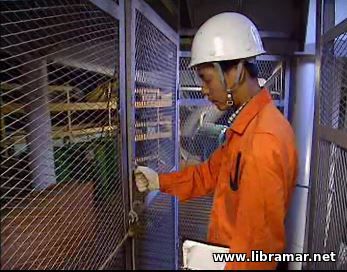 deck so that the response can be immediate and forceful.
deck so that the response can be immediate and forceful.
You need to keep away those people you do not want on board but also do care of those you do want. You must be sure that the stevedores are aware of any hazardous materials or special circumstances that present a hazard. Be sure that you know the status of the ship’s equipment. Are all the cranes fully operational? If not, notify the foreman in charge of the stevedores. Do not let the stevedores exceed the SWL of any crane.
Fire prevention is another job of the watchkeeping officer – he needs to keep an eye on all work being carried out on a ship and make sure that all risks are kept to a minimum. If there is work in enclose spaces of welding then the OOW that they are done as per the permit to work document and that all safety procedures are being observed.
All walkways and gangways should be kept clear of obstructions. Precautions must be taken to make them safe so that the visitors do not slip, trip or fall. Hatches not required for loading should be closed. If manholes are open, place 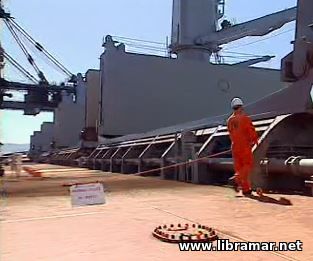 the lid partly over the hole and rope off potentially hazardous areas. Make sure that your ship is as safe as you can make it even for non-mariners.
the lid partly over the hole and rope off potentially hazardous areas. Make sure that your ship is as safe as you can make it even for non-mariners.
If the things do go wrong, make sure that you keep a record of what happened to give your owner evidence to protect him against claims. If the incident is followed by disputable claim, then the owner will need evidence to defend the case. Before the facts are readily available, disputes can often be settled promptly. Always inform the Master about any incident and treat everyone with the respect they deserve. Immediate politeness and concern can help avoid subsequent legal action.
Record the facts not your opinions. It may be years before the incident comes to court, that is why proper records will help to defend any future claim. Not only accidents but any event shall be recorded in the deck log. The company manuals and Master’s standing orders will have lists of the information that needs to be recorded, including ship’s draft, tidal changes, any testing of cargo systems, details of cargo and ballasting operations, notification of security arrangements and weather conditions. A complete, clear and uninterrupted deck log shows the operator, the Master and any surveyor or lawyer that the duties of the OOW have been done properly and demonstrates that the officer paid attention to everything that has occurred on board. Note any relevant event and action in the log.
The watchkeeping officer also maintains the garbage log. There is a legal requirement to record the time, quantity and type of every discharge of garbage. You will be asked to sign various documents by shore personnel. Only sign documents that the standing orders authorize you to sign. Before you sign, read the document and make sure you understand it and that it is correct. If you are uncertain, get the chief officer or master to look at the document before 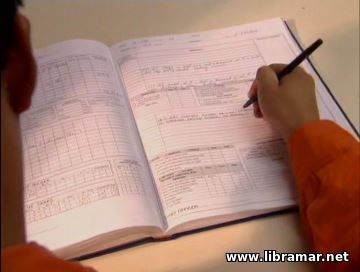 you sign.
you sign.
To carry out a successful watch, it is important to start outright and get to the watch handover point with plenty of time, have a good look at the deck log. The outgoing watchkeeper will want to ensure that you are properly informed of everything that has happened and what cargo and ballasting operations can be expected during the watch. Make sure know who is on board including all visitors and their expected departure time. Be sure you have or know where to find all the keys for the ship’s storages. Be certain that you are familiar with the master’s standing orders. Check that you are aware of everything happening on board.
The "Read Later" function allows you to add material to this block with just one click. Just click on the icon and read the articles that interest you at any convenient time.
